The Slabs

When you enter Slab City, you are greeted by a concrete military sentry box painted over with flying doves and what looks like a Christmas tree. Immediately two things are clear – nothing here is what it seems and this place is full of stark contrast. It is called Slab City because it was once a WWII military base that was razed except for some large concrete slabs that now make up its rough infrastructure.

There is no water. There is no electricity. Living there is primitive and hard. Most seasonal residents come in RVs with toilets and generators. The only nearby town, Niland, has a post office, a laundrymat, library, two restaurants and two smallish markets (which may or may not be open).

We arrive after a long hot day of riding the 111. We are tired and are searching for a place to camp. I discover I have a flat in the front and instead of unloading all the gear to patch it, I am pumping air every twenty minutes into the tire. There is a general air of lawlessness in The Slabs – atleast on the surface. “Street signs” are hand drawn and crude, RVs and trailers are arranged in somewhat regular intervals but there are no real obvious boundaries. Despite the appearance of chaos there was order – we just had to find it.

While we riding around the Slabs, someone yelled for us to stop. He ran up to met us, eyes aglow with a big gap toothed grin. “Did you just get here?” he asked. “Yes.” “Well welcome to the Slabs,” he said holding out a single black stained hand. He caught this at the last moment and apologized. He was polishing some aluminum for someone. “Gotta make money here,” he said.
He told us he just rode here by bicycle from Oregon about a month ago with all his earthly belongings in a trailer and decided to live here. “I’ve only been here a month and look at what I have,” he said genuinely enthusiastic and gesturing rather grandly toward a small camper trailer with no wheels. He was very proud of it. He had purchased it for $25 from someone else in the Slabs and dragged it to now its permanent address in Slab 20. “It had no wheels just the leaf springs. You can still see where it dragged through the dirt.”
He had created an awning for the trailer with some scrap metal and a firepit in front of the trailer from broken slabs of concrete. There were two dogs running around the trailer barking up a storm. He, in his own way, had recreated a version of the American dream for himself here. The trailer was his castle here in Slab City and he was his own master here in the last free place on earth.
We moved on and met a foursome that was coming back from a walk. They were snowbirds, 2 Germans and 2 Canadians. They give us the lay of the land and tell us that we are free to camp anywhere and that we could join them on the plot of dirt they had found for themselves. They are friendly and kind, fellow travelers and it feels good to meet some warm faces. Laura and I decide to set up camp by some bushes not too far from their trailers and call it home. While we are setting up our tent, the Canadian woman walks towards us with a smile holding a gallon of water. Water is a precious commodity here. There is never enough. We gratefully accept her welcome gift.

That night we set up camp and fall asleep to the sounds of RV generators humming into the night and of laughter sometimes joyful and sometimes maniacal from the bushes across the road.
The next day we are set on exploring the Slabs. First we go to the dump, a stretch of land just past a wash where those in the Slabs bring their trash, their couches, their broken electronics, car parts, burned out mattresses, broken appliances big and small and endless multitudes of things. Just past the dump on top of a hill is The Library and its an honest to god library. There are probably a few thousand books and magazines in a makeshift open air structure. You are free to take and return books at your leisure. There is a lounge and reading area with a fire pit.

After the library we weave in and out of the matrix of the Slabs. There are RVs with satellite dishes and luxurious outdoor spaces next to small rusted trailers and shacks. There are gray haired snowbirds well coifed and clean “camping” next to hard faced men with wild hair keeping warm over a trash fire. It is hard to make sense of this space. Every slab brings something new and unexpected. We see what looks like a restaurant run out of a converted school bus with old couches as booths. We stumble upon The Skatepark, an empty pool covered in paint and graffiti with rails and ramps. We pass by The Range, the music stage in Slab City that boasts live performances every Friday night.

It is a bizarro world, familiar but worn down, sun burnt and falling apart.
When we get to The Oasis, the coffee is all gone, but Matt, a rough looking Bukowski-esque old man with a nicotine stained beard that wraps around his head like a lion’s mane except for where its covered by a dusty truckers cap, offers to make some. He has been coming to the Slabs for about a decade and runs The Oasis.

He looks like he has seen better days but he is an utmost gentleman and speaks eloquently with a dry wit as he makes our coffee. “It’s primitive here,” he says “but it’s nice.” He likes being off the grid. He likes that here in the Slabs he is left alone except for the company he chooses to keep. And yet, it’s a hard life here though. “In the summer, even the preacher leaves,” he says, “Hell doesn’t need a preacher.”
He use to be a high school teacher before the Slabs, but that was ages ago.
While we are having our coffee, a steady stream of characters come and go. One pear-shaped old man comes and talks with us. He tells us how he use to volunteer at free clinics, how he has been on the road the last fifteen years and has lived year round at the Slab for five years, how he lost contact with his brother and family but reconnected with them recently through Facebook.
Every sun burned, dust covered face has their own story, their own unique tragedy or tale of escape that has brought them to the Slabs. We hear snippets and loose threads that make up the strange patchwork tapestry of the place but we have to keep moving.
We pack up the next day feeling like we have only scratched the surface of the Slabs. It is a deep cave that one could explore for months, but we have to get moving. As if to punctuate the bizarre contrast of the place, on our way out we see a woman in a pink velour track suit power walking along the cracked gravel road. She passes a man who has not seen soap nor shower for months huddled over a trashcan fire in front of a rusty old trailer.

That is the Slabs – a strange melting pot, a run down bizarro version of our reality. It is a place where a man has painted a mountain of dirt and rocks and made it beautiful. It is a place where you are greeted by an empty, cracked, concrete, military sentry box from WWII painted with doves.
15 Comments
Leave a Reply
This site uses Akismet to reduce spam. Learn how your comment data is processed.
Subscribe
Patreon
Join Team Supple on Patreon
PayPal

Very nice article and photos. Wasn’t this one of the sites in “Into the Wild”?
It is from “Into the Wild”- I’m currently reading it and that’s why I was looking up the Slabs. I’d heard of it before but had never looked into it. Very interesting!
Good writeup on the place. I helped a professional British film crew try to document the Slabs for a feature piece. It didn’t take long for them to decide it couldn’t be done, and they left for a place called “LA,” it’s the Hispanic section of Los Angeles. Grifter politicians from Sacramento have made annual pilgrimages to the Slabs only to always discover there’s nothing at the Slabs to swindle or steal.
Such a weird place – ;ike something out of a sci-fi novel! Love your blog.
That was a wonderful post to read, thank you for posting it. The Slabs sounds like a fascinating place to visit.
Yes it was, Marsha. Great movie. Very cool that you were at the Slabs, Russ & Laura. Maybe you can get back there some day and spend a bit more time.
Wow, a very interesting place. The movie, “Into The Wild” is also about a wander-lust journey with a wonderful moral to the story: “don’t put anything in your mouth you can’t identify”. Thanks so much for sharing your journey.
Happy Trails, Jack
Great photos on here, and a fab journey you are doing – well done!
First off, Great story!
Secondly, got my calendar last week. You and LuLu did a great job
Thank you,
DC
Wow, this is such a stark contrast to the places you guys have been before! I have seen that painted mountain of dirt, it looks really interesting.
DC,
Thanks! Glad to know you are diggin the calendar!
R
i do have to say that i have been out to The Slabs for 12 yrs mostly on the weekends. and all of my friends live there, and most time pep that “document” there time and it most times it is not as nice as your words and yes you may be saying the same thing but diplomacy can cover the heart of a person that is emotionally linked to The Slab! so thank you so much for your wording and your intent!!
[…] us about Slab City for years. Finally, on our trip, we decided to go out there (see our post “The Slabs“). The riding is desolate and dusty. There are few “towns” in the area and we […]
I might go to the slabs when I get on SSI, in about three years.
Looks interesting.
Very interesting post that makes me think of places I have visited. You end up feeling you are so glad to have experienced the place/people/etc and upon reflection know you would never go back for all the money in the world.